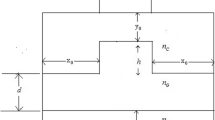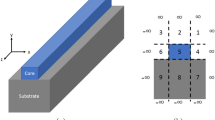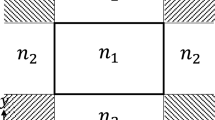Abstract
A modified alternating direction implicit approach is proposed to discretize the three-dimensional full-vectorial beam propagation method (3D-FV-BPM) formulation along the longitudinal direction. The cross-coupling terms (CCTs) are neglected at the first substep, and then double used at the second substep. The order of two substeps is reversed for each transverse electric field component so that the CCTs are always expressed in an implicit form, thus the calculation is efficient and stable. Based on the multinomial interpolation, a universal finite difference scheme with a high accuracy is developed to approximate the 3D-FV-BPM formulation along the transverse directions, in which the discontinuities of the normal components of the electric field across the abrupt dielectric interfaces are taken into account and can be applied to both uniform and non-uniform grids. The corresponding imaginary-distance procedure is first applied to a buried rectangular and a GaAs-based deeply-etched rib waveguide. The field patterns and the normalized propagation constants of the fundamental and the first order modes are presented and the hybrid nature of the full-vectorial guided-modes is demonstrated, which shows the validity and utility of the present approach. Then the modal characteristics of the deeply-and shallow-etched rib waveguides based on the InGaAsp/InGaAsP strained multiple quantum wells in InP substrate are investigated in detail. The results are necessary for modeling and the design of the planar lightwave circuits or photonic integrated circuits based on these waveguides.
Similar content being viewed by others
References
Nagarajan R, Joyner C H, Schneider R P, et al. Large-scale photonic integrated circuits. IEEE J Sel Top Quantum Electron, 2005, 11(1): 50–65
Kawano K, Kitoh T. Introduction to Optical Waveguide Analysis: Solving Maxwell’s Equations and the Schrodinger Equation. New York: Wiely, 2001. 117–229
Scarmozzino R, Gopinath A, Pregla R, et al. Numerical techniques for modeling guided-wave photonic devices. IEEE J Sel Top Quantum Electron, 2000, 6(1): 150–162
Huang W P, Xu C L. Simulation of three-dimensional optical waveguides by a full-vector beam propagation method. IEEE J Quantum Electron, 1993, 20(10): 2639–2649
Yamauchi J, Takahashi G, Nakano H. Full-vectorial beam-propagation method based on the McKee-Mitchell scheme with improved finite-difference formulas. J Lightwave Technol, 1998, 16(12): 2458–2464
Hseuh Y L, Yang M C, Chang H C. Three-dimensional noniterative full-vectorial beam propagation method based on the alternating direction implicit method. J Lightwave Technol, 1999, 17(11): 2389–2397
He Y, Shi F G. Improved full-vectorial beam propagation method with high accuracy for arbitrary optical waveguides. IEEE Photon Technol Lett, 2003, 15(10): 1381–1383
Yamauchi Y, Mugita T, Nakano H. Implicit Yee-mesh-based finite-difference full-vectorial beam-propagation method. J Lightwave Technol, 2005, 23(5): 1947–1955
Alcantara L D S, Teixeira F L, Cesar A C, et al. A new full-vectorial FD-BPM scheme: application to the analysis of magnetooptic and nonlinear saturable media. J Lightwave Technol, 2005, 23(8): 2579–2585
Press W H, Teukolsky S A, Vetterling W T, et al. Numerical Recipes in C-the Art of Scientific Computing. 2nd ed. New York: Cambridge University Press, 1992. 284–289
Yamauchi J, Ando T, Nakano H. Beam-propagation analysis of optical fibers by alternating direction implicit method. Electron Lett, 1991, 27(18): 1663–1665
Liu P L, Yang S L, Yuan D M. The semivectorial beam propagation method. IEEE J Quantum Electron, 1993, 29(4): 1205–1211
Rao H. Optical Electromagnetises Simulation of Strongly Reflective Structures for Integrated Photonics. New York: Columbia University Press, 2002. 181–185
Xiao J B, Sun X H, Zhang M D. Three-dimensional beam propagation method based on the variable transformed Galerkin’s method. Sci China Ser F-Info Sci, 2004, 47(1): 34–43
Chamorro-Posada P. A modified imaginary distance BPM for directly computing arbitrary vector modes of 3-D optical waveguides. J Lightwave Technol, 2003, 21(3): 862–867
Hadley G R. Transparent boundary condition for the beam propagation method. IEEE J Quantum Electron, 1992, 28(1): 363–370
Subdbo A S. Why are accurate computations of mode fields in rectangular dielectric waveguides difficult. J Lightwave Technol, 1992, 10(4): 418–419
Vassallo C. 1993–1995 optical mode solvers. Opt Quantum Electron, 1997, 29(2): 95–114
Xiao J B, Sun X H, Zhang M D. Vectorial analysis of optical waveguides by the mapped Galerkin method based on E fields. J Opt Soc Am B, 2004, 21(4): 798–805
Chung K H, Shim J I. A new polarization-insensitive 1.55 μm InGaAsP-InGaAsP multiquantum-well electroabsorption modulator using a strain-compensating layer. IEEE J Quantum Electron, 1999, 35(5): 730–736
Kohtoku M, Kawano K, Sekine S, et al. High-speed InGaAlAs-InAlAs MQW directional coupler waveguide switch modules integrated with a spotsize converter having a lateral taper, thin-film core, and ridge. J Lightwave Technol, 2000, 18(3): 360–369
Linnik M, Christou A. Design and performance of a vertical cavity surface emitting laser based on III–V quaternary semiconductor alloys for operation on 1.55 μm. IEEE Trans Electron Device, 2001, 48(10): 2228–2237
Chiu Y J, Wu T H, Cheng W C, et al. Enhanced performance in traveling-wave electroabsorption modulators based on undercut-etching the active-region. IEEE Photon Technol Lett, 2005, 17(10): 2065–2067
Tsuzuki K, Ishibashi T, Ito T, et al. A 40-Gb/s InGaAlAs-InAlAs MQW n-i-n Mach-Zehnder modulator with a drive voltage of 2.3 V. IEEE Photon Technol Lett, 2005, 17(1): 46–48
Soldano L B, Pennings E C M. Optical multi-mode interference devices based on self-imaging: Principles and applications. J Lightwave Technol, 1995, 13(4): 615–627
Author information
Authors and Affiliations
Corresponding author
Rights and permissions
About this article
Cite this article
Xiao, J., Liu, X., Cai, C. et al. An improved three-dimensional full-vectorial finite-difference imaginary-distance beam propagation method. SCI CHINA SER F 49, 516–532 (2006). https://doi.org/10.1007/s11432-006-2006-6
Received:
Accepted:
Issue Date:
DOI: https://doi.org/10.1007/s11432-006-2006-6




